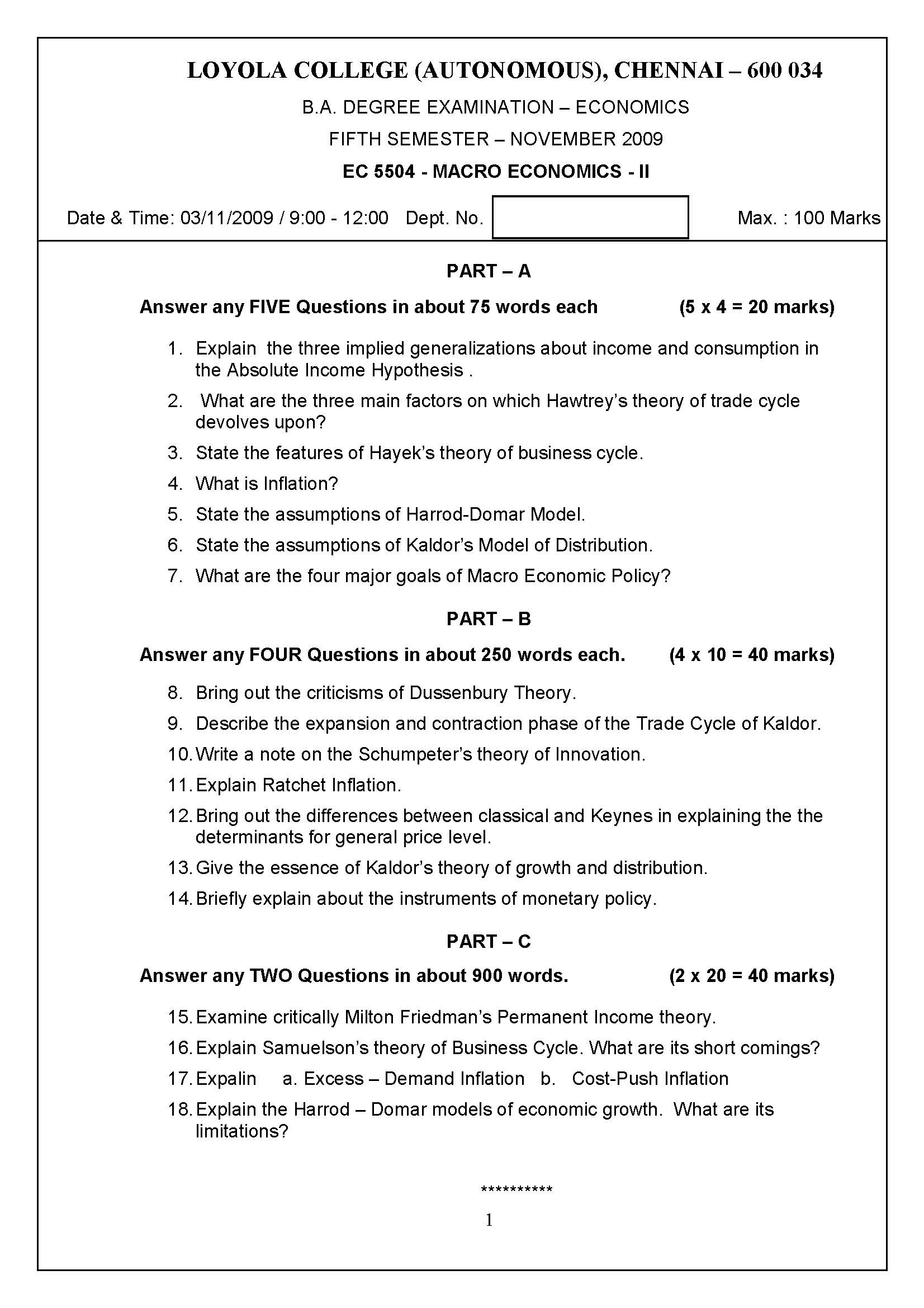LOYOLA COLLEGE (AUTONOMOUS), CHENNAI – 600 034
B.A. DEGREE EXAMINATION – ECONOMICS
FOURTH SEMESTER – April 2009
ST 4207/ ST 4204 – ECONOMETRICS
Date & Time: 27/04/2009 / 9:00 – 12:00 Dept. No. Max. : 100 Marks
SECTION A
Answer all the questions 10 x 2 = 20 marks
1 If A and B are two events such that P(AU B) = 0.57 , P( Ac ) = 0.50 and
P( Bc ) = 0.60 , find P( A ∩ B ).
- Mention any two properties of variance.
- If X is a continuous random variable having the probability density function
f (x) = (1/9) x2 , 0 ≤ x ≤ 3 ; 0 , elsewhere
find P(0 < X < 1).
- Define maximum likelihood estimation.
- Write a note on interval estimation.
- Define sample regression function.
- Distinguish between R2 and adjusted R2.
- Write the importance of dummy variables in regression models.
- Define variance inflating factor.
- Write any two consequences of multicollinearity.
SECTION B
Answer any five questions 5 x 8 = 40 marks
- If 10 fair coins are tossed simultaneously , find the probability of getting
(i) exactly 4 heads (ii) at least 8 heads (iii) at most 9 heads (iv) between 7 and 9 heads inclusive.
- Given the following probability distribution:
X=x : -3 -2 -1 0 1 2 3
p(x) : 0.05 0.10 0.30 0 0.30 0.15 0.10
Compute E(X) and V(X).
- Let X be normally distributed with mean 8 and standard deviation 4.
Find (i) P(5≤X≤10) (ii) P(10≤X≤15) (iii) P(X≥15) (iv) P(X≤5).
- A random sample of 10 boys had the following I.Q.’s: 70 120 110 101
88 83 95 98 107 100 .Construct 95% confidence limits for the population mean.
- Two random samples drawn from two normal populations are:
Sample I : 20 16 26 27 23 22 18 24 25 19
Sample II : 27 33 42 35 32 34 38 28 41 43 30 37
Test whether the populations have the same variances. Use 1% significance level. 16. Fit a regression model of the form
Y = β1 + β2X + u for the following data:
Y : 55 88 90 80 118 120 145 135 145 175
X : 80 100 120 140 160 180 200 220 240 260
Also find residual sum of squares.
- Explain the log-linear and semi log models.
- Explain the ANOVA for testing the equality of parameters for a k-
variable linear regression model.
SECTION C
Answer any two questions 2×20 = 40 marks
- Let X1 and X2 have the joint p.d.f.
f(x1,x2) = 2 , 0<x1<x2<1 : 0 , elsewhere.
- Find the marginal distributions of X1 and X2
- Find the conditional mean and variance of (i) X1 given X2 = x2 and
(ii) X2 given X1= x1.
- Find the correlation between X1 and X2.
- (a) Obtain the maximum likelihood estimators of μ and s2, if X1,X2,…Xn is
a random sample from normal distribution with mean μ and variance s2. .
(b) Fit a linear regression model of the form
Yi = β2 Xi + ui for the following data:
Y : 10 20 25 22 27 15 12
X : 8 12 15 13 16 10 9
Also find
- Standard error of slope parameter
- Residual sum of squares
- 95% confidence interval for β2.
- (a) Mention the assumptions underlying the method of least squares in the
classical regression model.
(b) Write a note on:
(i) t-distribution (ii) F-distribution (iii) Chi-square distribution
(iv) Normal distribution
- Fit a regression model of the form
Yi = β1 + β2 X2i + β3 X3i + ui for the following data:
Y : 1 3 8 11 15 14
X2 : 1 2 3 5 7 6
X3 : 2 1 4 3 5 4
Also find :
(i) Standard errors of estimators of β2 and β3.
(ii) Covariance between the estimators of β2 and β3.
Go To Main Page







